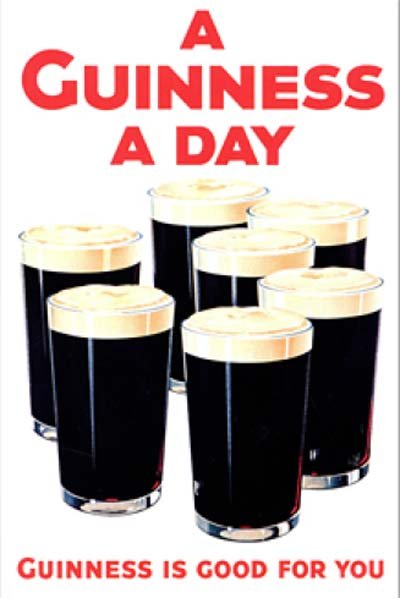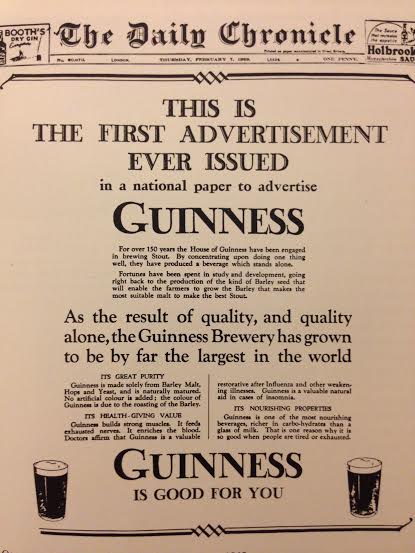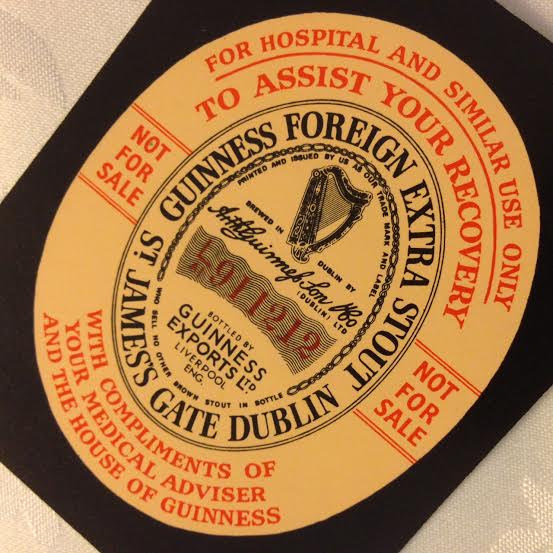AUTO - SUGGESTIVE GUINNESS - NOT FOR SALE!
If there is one product that has been at the centre of controversy as to its health benefits (or otherwise) over the centuries it has to be beer.
Medical opinion seems to sway erratically, even today.
One month we are warned that beer offers little or no nutritional benefits and even in moderate consumption could be harmful, only to hear this contradicted in the next.
A counter study carried out at a University in the next breadth will give a completely opposite assessment based on clinical trials. We will be told that beer contains anti-oxidants and compounds which are essential in maintaining healthy arteries and slows down harmful cholesterol, and also important vitamins such as B1, B2,B6, and B12.
What both camps do agree on, and is universally understood, is that excessive consumption outweighs any benefits.
Nevertheless the message remains ambiguous - although on balance the good news out weighs the bad!
One company who benefited more than most in the past from a 'positive' depiction of beers benefits is Guinness.
In a cleverly orchestrated strategy to tap in to the 'alleged' health benefits Guinness bestowed no other beer came close - yet the origins of this campaign were more by accident than design with the simplest of remarks forming an advertising campaign and approach that last more than 40 years.
TO ADVERTISE OR NOT?
In 1926 Guinness faced a quandary, which Lord Iveagh, Chairman of the company in Dublin felt needed to be addressed immediately. The brand seemed to be stagnating, a trade depression had taken its toll on sales, and he felt the time had arrived for Guinness to start advertising.
But quite how to go about this, and who should carry out the task (which carried a heavy responsibility if it failed) were undecided.
Guinness was already a well known brand by this time, and previous management had shunned advertising. The current board were concerned that the correct image should be portrayed and that any advertising (perhaps denting its quality image) may jeopardise its growth.
The contract was won by S.H.Benson Ltd., an advertising company which had been established in 1893, who's star player was one Oswald Greene...
Greene, a director, was regarded as the best copywriter in the company and had masterminded such successful campaigns as The Colman's Club for the mustard company and was equally successful with Hennessy Brandy and the Encyclopaedia Britannica.
Greene visited the brewery on several occasions, to assimilate the atmosphere and take in the production process.
He then decided to enlist the help of Bobby Bevan, and employee at Benson's and carry out some rudimentary 'market research'.
He reasoned that to get a better understanding of the product you needed to meet the people who actually consumed it, so along with Bevan he decided to visit some pubs and ask people why they actually drank Guinness.
Time and again they would receive the same reply Guinness "is good for you".
So frequent was the response that he felt he had hit upon the answer to his quest, and that this would form the new company advertising slogan!
Excited at what they had decided upon they presented it to the Guinness board - who were anything but impressed. They felt it was far to simplistic, and anyway why should you tell people what they already knew?



But as Greene remonstrated that WAS the point, by re-enforcing their beliefs, re-affirming their assessment of the product, and also persuading non Guinness drinkers to try the product and benefit from what it had to offer.
HEALTH BENEFITS, PRE NHS, AND TONICS...
The most important element within all this which Benson's wanted to force home, and which would form the controversial backbone to future advertising, was the 'health' aspect.
In January 1928 the first ever Guinness poster appeared in Scotland, and each was based around seven virtues that Guinness bestowed which made it the answer for a number of ills - such as Digestion, Exhaustion, Nervousness, Sleeplessness...and so forth.
Before the arrival of the National Health Service in 1948 newspapers were full of wondrous tonics, pills or potions. Many people may have viewed them with suspicion but as health was paramount they were a cheaper alternative than calling on the services of a doctor - something beyond the pocket of the working man.
A beer however that seemed to be a 'cure all' for a number of ills was a tempting, and dare we say, enjoyable way of fighting off any maladies - it was, in fact, the multi-vitamin of its day!
The first Guinness poster to appear in Britain was in Spring 1929, just over a year after the Scottish trial, and followed the same approach.
DOCTORS ORDERS...
What is not generally appreciated is that long before Benson's involvement Guinness was already being prescribed by Doctors for nursing mothers and convalescents.
A label as early as 1906 of Guinness Foreign Export Stout carries an endorsement as to the health benefits it offers.
In fact doctors in the medical profession almost lined up single handedly to back the Guinness cause with a level of enthusiasm that defied any medical logic giving 1000's of testimonials to the product.
Finally in 1936 the Federal Alcohol Administration in the USA raised objections to the 'Guinness is good for you' campaign on the grounds that there was no scientific fact to the claim.
In a bullish response Guinness prepared a dossier of fifty facsimile transcripts by doctors - who's reasoning seems to have left them somewhat in a flight of fancy...
One such endorsement was as follows: " I often prescribe Guinness, and for the following reasons in chief. A bottle of Guinness
in front of say, a dispirited, health greedy convalescent has a wonderfully auto - suggestive
cheer producing effect. It looks potent and jolly when consumed it acts as a stomachic and
whip to the appetite. It makes the patient feel better and eat better and think cheerfully".
M.B., B.Ch.
It would seem the snappy slogan adapted from the apple "A Guinness a day...." really did sink in to the medical profession psyche!
GUINNESS FOREIGN EXTRA STOUT LABEL - NOT FOR SALE
The Foreign Extra Stout label shown above is a fascinating reminder of the power of the brand within the medical profession. What is interesting is that this particular Guinness is Foreign Extra Stout, which unlike Guinness produced for the UK and Ireland (4.1 - 4.5%Alc/vol.) was considerably stronger at 7.5%Alc/vol.
The original purpose of the numbers running across the centre of the label was to indicate the bottling date and would be read right to left. By the early 1990's this method had been dropped and the numbers used formed purely part of the overall design and the date would be spurious.
It was bottled at Guinness's Export plant in Liverpool and being in English (as Guinness produced many labels in foreign languages) could have been exported to one of the dominions. The curious lettering, such as the L A1 above to the left of the number remains unknown in terms of purpose.
Surely this is one of the world's most intriguing labels, and for those convalescents lucky enough to encounter it no doubt must have worked a treat!
One bottle or two, that is the question...and of course...no charge...
-----------------------------------------------------------------------------------------------------------------
TO RETURN TO ARCHIVE CLICK ON ARROW TOP OF PAGE